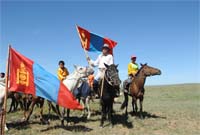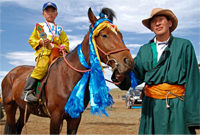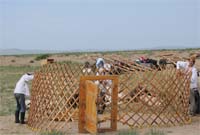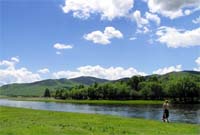Route 4
Adventures in the Gobi Desert
(the fifth largest desert in the World).
The Gobi Desert is the source of many important fossil finds, including the first dinosaur eggs and also sustain many animals, including black-tailed gazelles, ibex, argali-wild sheep, marbled polecats, bactrian camels and Mongolian wild ass and are occasionally visited by snow leopards, brown bears, and wolves.
Day 1.
Hotel check-in. Visit the Gandan Monastery, the national Buddhist religious center. Visit a museum and traditional Mongolian music and dancing concert.
Day 2.
Leave Ulaanbaatar for Baga Gazaryn Chuluu, with unique ecological and geological composition, located in Erdenedalai soum/district of Dundgobi aimag/province.
Day3-4.
Leave Baga Gazaryn Chuluu for “Tsagaan Suvarga” through Mandalgobi town. “Tsagaan Suvarga” (the White Stupa) one of the amazing creations of the mother nature.
Day 5.
Leave “Tsagaan Suvarga” for “Yolyn Am” located within the Gobi Gurvan Saikhan national park area. “Yolyn Am” is a deep gauge with a cool and fresh air due to glacier and permafrost presence in the area. Possible sighting of wild animals and large birds.
Day 6.
Leave “Yolyn Am” for Khongoriin Els and we will relax at the oasis of the Gobi desert.
Day 7.
Leave Khongoriin Els for Bayan Zag (saxaul tree forest) surrounded by red clay soil. This area is famous for its important fossil finds, including the first dinosaur eggs.
Day8-9.
Leave Bayan Zag for Ongiin Monastery one of the victims of the repression during the communist era in 1930s. Camp with nomadic herders and explore their livelihood, traditions and cultures.
Day 10.
Leave Ongiin Monastery for the Orkhon river valley tour, including a visit to the waterfall. This area is populated with the large number of yak herds.
Day 11.
Leave Orkhon river valley for Khar Korum- the ancient capital of Mongolia. Visit the Erdene Dzuu monestary founded by his Holiness the first Bogd Zanabazar - the spiritual leader and the head of state during the 17th century. Visit archeological sites.
Day 12.
Leave Khar Korum for Khögnö Khan Mountains, Khadagt Khoshuu – a shaman ritual site and sand dunes of Elsen Tasarkhai. Possible riding of two humped/Bactrian camels.
Day 13.
Leave Khögnö Khan Mountains for Khustai Mountains, Przewalski's horses, the last surviving subspecies of wild horse were reintroduced since early 1990’s.
Day 14.
Arrive in Ulaanbaatar and leisure time in the capital city.
Day 15.
Arrive at the airport and depart Ulaanbaatar.




